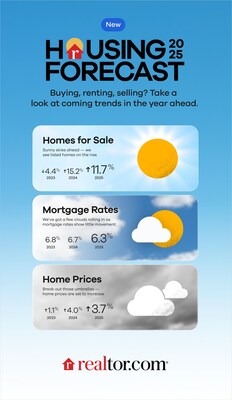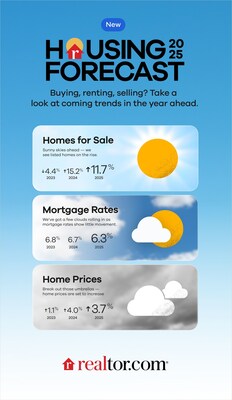Realtor.com® 2025 Housing Forecast: Will There be a "Trump Bump" in Housing Next Year?

Inventory gains bring first "balanced" market in nine years, as the Trump administration takes office
SANTA CLARA, Calif., Dec. 4, 2024 /PRNewswire/ -- Broader economic factors are expected to have a larger impact on the housing market than potential new federal policies in 2025, according to the Realtor.com® 2025 Housing Forecast released today. Realtor.com®'s forecast predicts home sale prices will grow by 3.7%, mortgage rates will stay above 6% and rents will remain virtually unchanged (-0.1%). Growth in inventory with single family home starts is expected to grow 13.8% and existing for-sale home inventory is expected to grow by 11.7%, which will help bring the first balanced market in nine years.
"While President-elect Trump can work quickly with his administration to implement some regulatory changes, other policies that will affect housing, such as tax changes and broad deregulation, require the cooperation of other branches and levels of government," said Danielle Hale, chief economist, Realtor.com®. "The size and direction of a Trump bump will depend on what campaign proposals ultimately become policy and when. For now, we expect a gradual improvement in housing market dynamics powered by broader economic factors. The new administration's policies have the potential to enhance or hamper the housing recovery, and the details will matter."
In 2025, Realtor.com® forecasts that buyers and sellers can expect:
- Average mortgage rates of 6.3%, with rates edging down over the year to reach 6.2% by the end of the year
- Home prices will grow by 3.7% continuing growth trends since 2012
- Rents will remain about the same with a slight 0.1% drop
- A 11.7% increase in existing home inventory continuing the trend from 2024
- Single-family new home starts will grow an impressive 13.8%, reaching 1.1 million homes, a figure not seen since 2006
- Home sales will grow 1.5% year over year to 4.07 million
- Months' supply, a key market balance indicator, is expected to improve from a 3.7 month average in 2024 to 4.1 months in 2025. Anything under 4 is typically considered a seller's market, while 4 to 6 months of supply is typically considered a balanced market.
How could President-elect Trump policies impact the housing forecast in 2025?
A Republican sweep of the presidency and both houses of Congress will likely result in pros and cons for the housing market. Among President Trump's proposals to address the housing shortage is making more federal land available for homebuilding and addressing regulation, which estimates suggest contributes to more than $90,000 of the cost of a new home, and could help bolster supply. Post election, markets have generally pushed longer-term rates higher, anticipating either higher inflation, larger deficits, stronger economic growth or some combination.
What should buyers and sellers expect in 2025?
Overall buyers and sellers should expect to see a more balanced market in 2025, which will require some give and take on both sides. Homebuyers frustrated by higher interest rates will have some buyer-friendly conditions in 2025, such as the highest for-sale inventory since December 2019 and nearly 20% of listings coming with price cuts. Mortgage rates are expected to improve slowly in 2025, but the drop likely won't move the needle back towards a seller's market. Buyers should expect a friendlier, less competitive housing market than in past years, although one that is still costly because of stubbornly high mortgage rates and home prices.
Limited inventory and strong demand in many areas could mean that sellers still have the upper hand in terms of negotiating prices, especially in desirable locations. However, higher interest rates or slower than expected income growth could lead to fewer buyers being able to afford homes, which might result in longer selling times or price reductions in some markets.
Key Trends and Wildcards to Watch in 2025:
Slight rebound in overall home sales – The 2025 forecast has home sales slightly increasing, with an expected annual count of sales to be 1.5% more than 2024, for an annual tally of 4.07 million sales. As mortgage rates ease back in 2025, the market is likely to see slightly more activity during the busier summer months, compared to last year.
Mortgage rates – While markets are factoring in expectations of a higher-rate environment than previously thought, there is uncertainty around which policies will take priority and whether the specifics match or merely rhyme with campaign promises. These details will matter for the outlook and for mortgage rates.
Rent prices will largely remain the same, more rental supply growth in the South – While the surge in new multifamily supply offers renters more options, the large renter population will dampen any significant impact on rental prices. The median asking rent in 2025 is expected to be only slightly lower than in 2024 (-0.1%). Looking ahead to 2025, recent construction trends suggest all four regions will see continued growth in rental stock, with the South leading at an annual increase rate of 1.5%, followed by the West (1.2%), Midwest (0.9%) and Northeast (0.7%). It is likely that Southern rental markets will maintain a relative affordability advantage in 2025.
Big increases in both new home sales and new home starts – While existing home sales are expected to remain largely unchanged for the year in 2025, new home sales and single-family housing starts are expected to outperform. With a substantial construction deficit over the last decade, builders have room to run and may get an additional boost from a builder-friendly administration that understands the need for more construction. Single-family starts are expected to total 1.1 million in 2025, an impressive 13.8% pickup over 2024.
"While more inventory means buyers will likely have more time to make purchase decisions in 2025, in any market, a fast-acting buyer will have a higher likelihood of making the winning offer," said Hale. "For this reason, it's wise to get prepared financially and for the home search overall. Thankfully for homebuyers there are more tools, like Realtor.com®'s dynamic map layer, to help home buyers and sellers get ready."
When faced with an overwhelming amount of market information, Realtor.com®'s dynamic map layers can help consumers make better sense of it. These new map-based search features allow buyers and sellers to explore a wide range of neighborhood and home details with just a quick glance, such as home estimates, lot size, year built, sold price, sold price per sq ft, market hotness, climate factors and more.
For more information about the Realtor.com® 2025 housing forecast, visit: https://www.realtor.com/research/2025-national-housing-forecast/
Local Market Predictions – 100 Largest U.S. Metros (in alphabetical order)
Metro | 2025 | 2025 Price |
Akron, OH | 15.0 % | 4.2 % |
Albany-Schenectady-Troy, NY | 10.3 % | 6.6 % |
Albuquerque, NM | -4.1 % | -4.2 % |
Allentown-Bethlehem et al, PA-NJ | 12.3 % | 8.0 % |
Atlanta-Sandy Springs et al, GA | 15.1 % | 10.2 % |
Augusta-Richmond County, GA-SC | 14.2 % | 5.8 % |
Austin-Round Rock, TX | 14.5 % | 10.2 % |
Bakersfield, CA | 9.9 % | 6.0 % |
Baltimore-Columbia-Towson, MD | 16.2 % | 2.7 % |
Baton Rouge, LA | 5.5 % | 2.7 % |
Birmingham-Hoover, AL | -8.3 % | 2.3 % |
Boise City, ID | 2.0 % | 12.3 % |
Boston-Cambridge-Newton, MA-NH | -1.8 % | 5.6 % |
Bridgeport-Stamford-Norwalk, CT | -5.4 % | 4.9 % |
Buffalo-Cheektowaga et al, NY | 9.7 % | 8.5 % |
Cape Coral-Fort Myers, FL | 13.2 % | 9.6 % |
Charleston-North Charleston, SC | 5.8 % | 7.0 % |
Charlotte-Concord et al, NC-SC | 15.7 % | 8.4 % |
Chattanooga, TN-GA | 2.2 % | 6.3 % |
Chicago et al, IL-IN-WI | 12.4 % | 4.5 % |
Cincinnati, OH-KY-IN | 8.2 % | 7.3 % |
Cleveland-Elyria, OH | 9.4 % | 5.0 % |
Colorado Springs, CO | 27.1 % | 12.7 % |
Columbia, SC | 12.1 % | 8.2 % |
Columbus, OH | 3.4 % | 5.7 % |
Dallas-Fort Worth-Arlington, TX | 7.6 % | 9.2 % |
Dayton-Kettering, OH | 2.3 % | 4.3 % |
Deltona-Daytona Beach et al, FL | 7.2 % | 11.5 % |
Denver-Aurora-Lakewood, CO | 13.6 % | 8.0 % |
Des Moines-West Des Moines, IA | 2.7 % | 4.9 % |
Detroit-Warren-Dearborn, MI | 2.4 % | 6.2 % |
Durham-Chapel Hill, NC | 14.1 % | 10.1 % |
El Paso, TX | 19.3 % | 8.4 % |
Fresno, CA | 8.1 % | 5.1 % |
Grand Rapids-Wyoming, MI | 3.9 % | 7.7 % |
Greensboro-High Point, NC | 17.3 % | 7.7 % |
Greenville-Anderson-Mauldin, SC | 5.1 % | 8.9 % |
Harrisburg-Carlisle, PA | 16.8 % | 5.1 % |
Hartford-West Hartford et al, CT | 3.8 % | 5.6 % |
Houston-The Woodlands et al, TX | 7.2 % | 7.3 % |
Indianapolis-Carmel-Anderson, IN | 7.7 % | 8.2 % |
Jacksonville, FL | 13.5 % | 9.8 % |
Kansas City, MO-KS | 6.7 % | 6.9 % |
Knoxville, TN | 3.7 % | 8.3 % |
Lakeland-Winter Haven, FL | 10.6 % | 10.3 % |
Lansing-East Lansing, MI | 10.3 % | 4.9 % |
Las Vegas-Henderson-Paradise, NV | 5.5 % | 12.3 % |
Little Rock et al, AR | 18.6 % | 4.8 % |
Los Angeles-Long Beach et al, CA | 4.2 % | 5.5 % |
Louisville et al, KY-IN | 4.6 % | 6.1 % |
Madison, WI | -8.4 % | 5.5 % |
McAllen-Edinburg-Mission, TX | 19.8 % | 7.0 % |
Memphis, TN-MS-AR | 8.3 % | 10.5 % |
Miami-Fort Lauderdale et al, FL | 24.0 % | 9.0 % |
Milwaukee-Waukesha et al, WI | 8.6 % | 5.7 % |
Minneapolis et al, MN-WI | 6.3 % | 6.2 % |
Nashville-Davidson et al, TN | 4.5 % | 8.3 % |
New Haven-Milford, CT | -8.4 % | 9.7 % |
New Orleans-Metairie, LA | 1.7 % | 5.9 % |
New York-Newark et al, NY-NJ-PA | 11.0 % | 5.9 % |
North Port-Sarasota et al, FL | 3.2 % | 10.4 % |
Ogden-Clearfield, UT | 2.2 % | 11.8 % |
Oklahoma City, OK | 8.4 % | 6.6 % |
Omaha-Council Bluffs, NE-IA | 2.5 % | 5.8 % |
Orlando-Kissimmee-Sanford, FL | 15.2 % | 12.1 % |
Oxnard-Thousand Oaks-Ventura, CA | 8.2 % | 8.0 % |
Palm Bay-Melbourne et al, FL | 0.8 % | 9.6 % |
Philadelphia et al, PA-NJ-DE-MD | 12.3 % | 6.1 % |
Phoenix-Mesa-Scottsdale, AZ | 12.2 % | 13.2 % |
Pittsburgh, PA | 1.9 % | 4.7 % |
Portland-South Portland, ME | -1.5 % | 6.1 % |
Portland-Vancouver et al, OR-WA | 11.1 % | 6.7 % |
Providence-Warwick, RI-MA | -14.7 % | 7.2 % |
Raleigh, NC | 2.2 % | 9.0 % |
Richmond, VA | 21.6 % | 6.1 % |
Riverside et al, CA | 11.4 % | 8.8 % |
Rochester, NY | 8.7 % | 6.8 % |
Sacramento--Roseville et al, CA | 5.2 % | 8.9 % |
Salt Lake City, UT | 9.7 % | 7.1 % |
San Antonio-New Braunfels, TX | 6.7 % | 10.0 % |
San Diego-Carlsbad, CA | 10.9 % | 9.1 % |
San Francisco-Oakland et al, CA | 3.4 % | 7.3 % |
San Jose-Sunnyvale et al, CA | 4.6 % | 7.5 % |
Scranton--Wilkes-Barre et al, PA | -10.3 % | 4.0 % |
Seattle-Tacoma-Bellevue, WA | 11.6 % | 5.7 % |
Spokane-Spokane Valley, WA | 12.2 % | 6.9 % |
Springfield, MA | -0.4 % | 8.7 % |
St. Louis, MO-IL | 11.0 % | 6.8 % |
Stockton-Lodi, CA | 6.2 % | 9.8 % |
Syracuse, NY | 1.7 % | 6.7 % |
Tampa-St. Petersburg et al, FL | 9.1 % | 11.8 % |
Toledo, OH | 10.8 % | 6.7 % |
Tucson, AZ | 12.5 % | 12.4 % |
Tulsa, OK | 2.5 % | 6.5 % |
Urban Honolulu, HI | 13.4 % | 6.7 % |
Virginia Beach et al, VA-NC | 23.4 % | 6.6 % |
Washington et al, DC-VA-MD-WV | 17.0 % | 5.0 % |
Wichita, KS | 3.0 % | 6.2 % |
Winston-Salem, NC | 7.7 % | 9.2 % |
Worcester, MA-CT | 1.2 % | 8.0 % |
Methodology
Realtor.com®'s model-based forecast uses data on the housing market and overall economy to estimate values for these variables for the year ahead. The forecast result is a projection for annual total home sales increase (total 2025 existing-home sales vs. 2024) and annual median home sales price increase (2025 median existing-home sales price vs. 2024).
About Realtor.com®
Realtor.com® is an open real estate marketplace built for everyone. Realtor.com® pioneered the world of digital real estate more than 25 years ago. Today, through its website and mobile apps, Realtor.com® is a trusted guide for consumers, empowering more people to find their way home by breaking down barriers, helping them make the right connections, and creating confidence through expert insights and guidance. For professionals, Realtor.com® is a trusted partner for business growth, offering consumer connections and branding solutions that help them succeed in today's on-demand world. Realtor.com® is operated by News Corp NWS NWSA]) [ASX: NWS, NWSLV] subsidiary Move, Inc. For more information, visit Realtor.com®.
Media Contact
Mallory Micetich, press@realtor.com
![]() View original content to download multimedia:https://www.prnewswire.com/news-releases/realtorcom-2025-housing-forecast-will-there-be-a-trump-bump-in-housing-next-year-302321673.html
View original content to download multimedia:https://www.prnewswire.com/news-releases/realtorcom-2025-housing-forecast-will-there-be-a-trump-bump-in-housing-next-year-302321673.html
SOURCE Realtor.com
© 2024 Benzinga.com. Benzinga does not provide investment advice. All rights reserved.
source
Breaking news
See all







